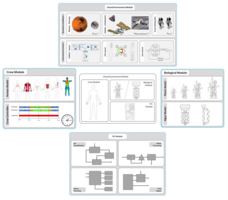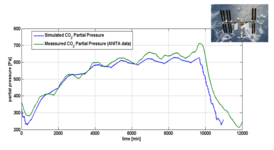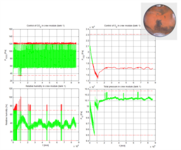Objectives
The state of the art Life Support System (LSS) design process is based on the static concept of Equivalent System Mass established by NASA. It allows selecting technologies with the lowest mass, volume, power, cooling, and maintenance requirements. The ESM approach is based on average mass flow relationships and does not provide information about the dynamic stability of the designed system.
With the Virtual Habitat (V-HAB) LSS architectures can by dynamically simulated exposing the systems to predefined mission scenarios including failures, and such revealing the robustness of the investigated system. With this approach V-HAB extend the Equivalent System Mass concept.
The current LRT research in this area focuses on the derivation of LSS reliability and on the prediction of crew performance for different mission scenarios
Statement of work
To provide the necessary transient characteristics, relevant LSS subsystems, including the crew, must be characterized in a dynamic manner. Since LSS experiments are costly and time consuming, the experimental derivation of dynamic LSS parameters is rarely possible.
In the past, computer simulations have been suggested as a possible solution to this problem. The realization of this vision is the core of the Virtual Habitat (V-HAB).
V-HAB includes all necessary modules to dynamically simulate LSS operations for complete mission scenarios, creating an integral LSS modeling suite. Among others, V-HAB is equipped with a dynamic and environmentally sensitive crew model, which covers one of the shortcomings of past LSS simulation efforts.
The ability of V-HAB to support LSS analyses with dynamic simulations of relevant mission scenarios was demonstrated in relevant case studies. Results of two typical simulations are shown below.
The first simulation depicts the International Space Station (ISS) where simulated results showed an excellent correspondence with measured values.
The second case study investigated a possible bio-regenerative Mars mission LSS architecture. Here it was shown that the ESM designed LSS cannot sustain stability when exposed to dynamic failure scenarios.
The results prove that a tool like V-HAB is able to effectively predict LSS environmental conditions and their impact on the crew. The findings are a first proof of concept that entire mission scenarios can be successfully simulated before actual LSSs are built. With detailed knowledge of boundary conditions, a modeling suite like V-HAB can be a legitimate LSS design and analysis tool.
References
[1] Honne, A., et al. Evaluation of ANITA Air Monitoring on the International Space Station. SAE Technical Paper. 2009-01-2520, 2009.
[2] Zhukov, A., Czupalla, M. and Stuffler, T. Correlation of the ISS Life Support System Simulation with ANITA data. SAE Technical Paper. 2010-01-0205, 2010.
[3] Czupalla, Markus The Virtual Habitat – Integral Modeling and Dynamic Simulation of Life Support Systems., Ph.D. Thesis Technische Universität München, Verlag Dr. Hut 2011, ISBN 978-3843903059
[4] Czupalla, M., Horneck, G. and Blome, H.J. The conceptual design of a hybrid life support system based on the evaluation and comparisons of terrestrial testbeds. Adv. Space Res. Vol. 35, pp. 1609-1620, 2005.



